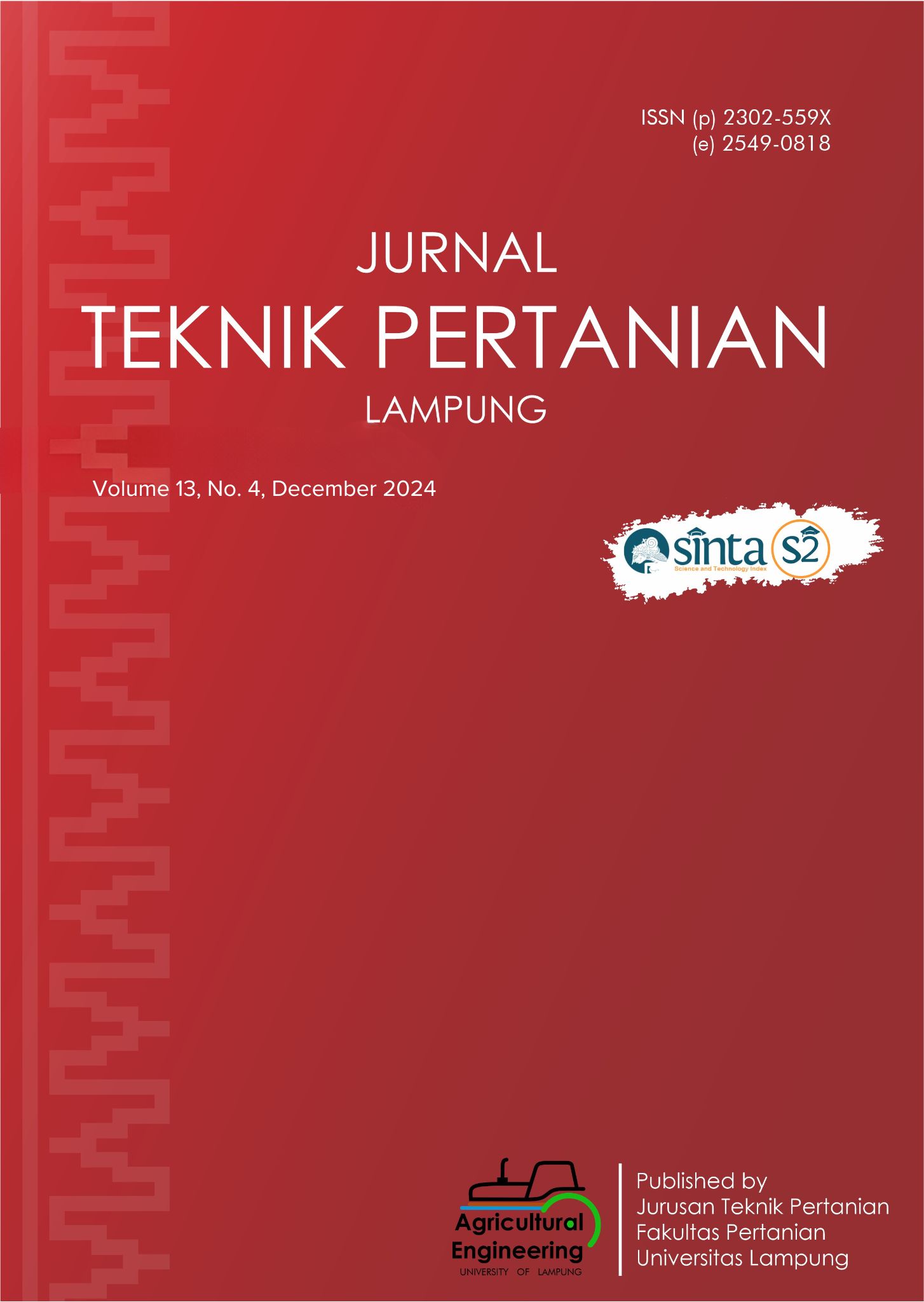Optimization of used engine oil Furnace Design with Initial Heater
DOI:
https://doi.org/10.23960/jtep-l.v13i4.1237-1248Abstract
Used engine oil is a waste from various types of machinery that has potential as an alternative fuel. The viscous characteristics of used engine oil require viscosity adjustment to be utilized as fuel. Nowadays used engine oil burners are generally using an external heater as an initial preheater, which causes the thermal efficiency decreased. The aims of this study are optimizing the design of the used engine oil burner by adding an initial heater and to find the optimum operating conditions of the burner to improve thermal. The initial heater is a spiral-shaped heat exchanger around the flame inside the burner, using its heat to decrease the viscous of used engine oil, so the used engine oil can be used as burner fuel. This study is varying the combustion air flowrate at 3.210-3 kg/s, 4.610-3 kg/s, and 6.410-3 kg/s and fuel rates of 2.110-4 kg/s, 3.110-4 kg/s, and 4.310-4 kg/s so the best performance of the burner will be observed. The results were obtained the best burner performance air flowrate of 4.610-3 kg/s and fuel flow rate of 4.310-4 kg/s, producing flue gas heat of 544°C, useful energy of 2.69 kW, and a resulting thermal efficiency of 59.54%.
Keywords: Burner, Design optimization, Initial heater, Used engine oil, Viscosity.
References
Arif, A., Hidayat, N., Purwanto, W., Setiawan, M.Y., & Masykur, M. (2021). pengaruh penggunaan oli bekas sebagai bahan bakar terhadap SFC dan efisiensi termal mesin diesel. J Mekanova Mek Inov dan Teknol, 7(1), 58. https://doi.org/10.35308/jmkn.v7i1.3730
Azharuddin, Sani, A.A., & Ariasya, M.A. (2020). Proses pengolahan limbah B3 (oli bekas) menjadi bakar cair dengan perlakuan panas yang konstan. J Austenit, 12(2), 48–53.
Bauer, R., Gölles, M., Brunner, T., Dourdoumas, N., & Obernberger, I. (2010). Modelling of grate combustion in a medium scale biomass furnace for control purposes. Biomass and Bioenergy, 34(4), 417–427. https://doi.org/10.1016/j.biombioe.2009.12.005
Dahlan, M.H., Setiawan, A., & Rosyada, A. (2014). Pemisahan oli bekas dengan menggunakan kolom filtrasi dan membran keramik berbahan baku zeolit dan lempung. J Tek Kim, 20(1), 38–45.
Grimmig, R., Lindner, S., Gillemot, P., Winkler, M., & Witzleben, S. (2021). Analyses of used engine oils via atomic spectroscopy – Influence of sample pre-treatment and machine learning for engine type classification and lifetime assessment. Talanta, 232, 122431. https://doi.org/10.1016/j.talanta.2021.122431
Hakim, M. (2020). Uji eksperimen bahan bakar kompor ekonomis dari oli bekas. [Undergraduate thesis]. Universitas Panca Marga Probolinggo.
Hidayat, A.R., & Basyirun, B. (2020). Pengaruh jenis oli bekas sebagai bahan bakar kompor pengecoran logam terhadap waktu konsumsi dan suhu maksimal pada pembakaran. Jurnal Dinamika Vokasional Teknik Mesin, 5(2), 103-108. https://doi.org/10.21831/dinamika.v5i2.34802
Holman, J.P. (2001). Heat transfer (10th ed.). McGraw-Hill.
Jafari, A.J., & Hassanpour, M. (2015). Analysis and comparison of used lubricants, regenerative technologies in the world. Resources, Conservation and Recycling, 103, 179-191. https://doi.org/10.1016/j.resconrec.2015.07.026
Khatimah, H.K., Hernawati, H., & Rahmaniah, R. (2016). Uji kualitas fisis pengolahan limbah oli bekas menjadi bahan bakar alternatif dengan metode distilasi sederhana. JFT: Jurnal Fisika dan Terapannya, 3, 41-50.
Kusnadi, A., Djafar, R., & Mustofa, M. (2020). Pemanfaatan oli bekas sebagai bahan bakar alternatif kompor yang ramah lingkungan. JTPG (Jurnal Teknologi Pertanian Gorontalo), 5(2), 49-55. https://doi.org/10.30869/jtpg.v5i2.681
Lekpradit, T., & Namkhat, A. (2017). Two-stage combustion burner using used engine oil as fuel. Key Engineering Materials, 751, 442-448. https://doi.org/10.4028/www.scientific.net/KEM.751.442
Madhusudan, S., Vismay, K.G., & Gururaja, S. (2017). Design and fabrication of oil burner, based on used engine oil as a sustainable source of energy. Imperial Journal of Interdisciplinary Research (IJIR), 3(1), 262-268.
Mahardhika, K.E., Santoso, D.T., & Kardiman, K. (2020). Pengaruh kecepatan udara dan debit bahan bakar pada pembakaran burner berbahan bakar oli bekas. JTM-ITI (Jurnal Teknik Mesin ITI), 4(3), 94-98. https://doi.org/10.31543/jtm.v4i3.451
Pangesti, R., Jati, D.R., & Asban, G.C. (2022). Perencanaan pengelolaan limbah bahan berbahaya dan beracun (B3) pada perusahaan kelapa sawit (Studi kasus: PT X di Kalimantan Barat). Jurnal Rekayasa Hijau, 6(3), 208-218.
Paraschiv, L.S., Serban, A., & Paraschiv, S. (2020). Calculation of combustion air required for burning solid fuels (coal / biomass / solid waste) and analysis of flue gas composition. Energy Reports, 6(3), 36-45. https://doi.org/10.1016/j.egyr.2019.10.016
Pratama, A., Basyirun, B., Atmojo, Y.W., Ramadhan, G.W., & Hidayat, A.R. (2020). Rancang bangun kompor (burner) berbahan bakar oli bekas. Majalah Ilmiah Mekanika, 19(2), 95-103. https://doi.org/10.20961/mekanika.v19i2.42378
Prayitno, D., Riyono, J., & Pujiastuti, E. (2021). Pemanfaatan oli bekas sebagai bahan bakar. Jurnal Abdi Masyarakat Indonesia (JAMIN), 3(2), 188-194. https://doi.org/10.25105/jamin.v3i2.6951
Ramadhan, G.W., & Basyirun, B. (2020). Pengaruh tekanan udara terhadap temperatur pembakaran oli bekas pada kompor. Jurnal Dinamika Vokasional Teknik Mesin, 5(2), 163-168. https://doi.org/10.21831/dinamika.v5i2.34804
Siskayanti, R., & Kosim, M.E. (2017). Analisis pengaruh perbedaan jenis minyak lumas dasar (base oil) terhadap mutu pelumas mesin. Prosiding SemnasTEK 2017, 1–8.
Tahfifah, A., Lestari, H.D., & Gunawan, S. (2016). Pra desain pabrik lube base oil dari oli bekas dengan proses ekstraksi solvent. Jurnal Teknik ITS, 5(2), F206-F211. https://doi.org/10.12962/j23373539.v5i2.16857
Downloads
Published
Issue
Section
License
- Authors who publish with this journal agree to the following terms:
- Authors retain copyright and grant the journal right of first publication with the work simultaneously licensed under a Creative Commons Attribution-ShareAlike 4.0 International Lice that allows others to share the work with an acknowledgement of the work's authorship and initial publication in this journal.
- Authors are able to enter into separate, additional contractual arrangements for the non-exclusive distribution of the journal's published version of the work (e.g., post it to an institutional repository or publish it in a book), with an acknowledgement of its initial publication in this journal.
- Authors are permitted and encouraged to post their work online (e.g., in institutional repositories or on their website) prior to and during the submission process, as it can lead to productive exchanges, as well as earlier and greater citation of published work (See The Effect of Open Access).
Jurnal Teknik Pertanian Lampung

JTEPL is licensed under a Creative Commons Attribution-ShareAlike 4.0 International License.

